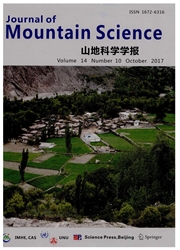

 中文摘要:
中文摘要:
在面临导致人的风景变化时管理并且恢复植物社区的能力可以依靠我们预言怎么的能力种类对环境变量作出回应。理解这回答要求检验在植物和资源可获得性上有影响的因素或他们的相互作用。我们的目的是包括土壤在环境产地因素之中在植物丰富和相互作用分析在变化之间的关系,地质(岩石类型) ,并且在 Longhushan 石灰岩地区常见的地形山生态系统的另外的环境变量。种类密度和优势用 ANOVA, ANCOVA,和建立这些组因素的单个或联合的效果的概括线性模型被检验。结果证明在丰富的趋势被岩石类型主要影响(与白云石和方解石的百分比内容有关) ,与地形学联合的土壤特征。两个植物索引在白云石是更高的统治了区域并且与潮湿,和举起断然变化了,但是否定地与有机物,当密度也与斜坡度增加了时。结果证明在种类丰富的重要变化从土壤与变量的联合被生产,地质、环境的因素,在植物上建议他们的相互作用影响。我们要求那除了是的水和滋养的可获得性的碳酸盐岩石类型主要由象土壤质地和温度那样的地形学和另外的因素控制了的在生态系统取决于的在石灰岩地区常见的地形的植物丰富的空间变化。学习建议在石灰岩地区常见的地形,区域焦化岩石除了本地环境变量,当分析在植物社区上有影响的因素时,类型应该被考虑。
 英文摘要:
英文摘要:
The ability to manage and restore plant communities in the face of human-induced landscape change may rely on our ability to predict how species respond to environmental variables.Understanding this response requires examining factors or their interactions that have influence on plant and resource availability.Our objective was to analyze the relationships between changes in plant abundance and the interaction among environmental habitat factors including soil, geological(rock type), and other environmental variables in the Longhushan karst mountains ecosystem.Species density and dominance were examined using ANOVA, ANCOVA,and Generalized Linear Models to establish the single or combined effects of these groups of factors.The results showed that trends in abundance were mainly affected by rock type(related to the percentage content of dolomite and calcite), soil characteristics in association with topography.Both plant indices were higher in dolomite dominated areas and varied positively with moisture, and elevation, but negatively with organic matter, while density also increased with slope degree.The results demonstrate that significant variations in species abundance was produced with the combination of variables from soil, geological, andenvironmental factors, suggesting their interaction influence on plants.We postulate that spatial variations in plant abundance in karst ecosystem depends on the carbonate rock type in addition to water and nutrient availability which are mainly controlled by topography and other factors such as soil texture and temperature.The study suggests that in karst areas carbonate rock type, in addition to local environmental variables, should be taken into account when analyzing the factors that have impact on plant communities.
 同期刊论文项目
同期刊论文项目
 同项目期刊论文
同项目期刊论文
 Towards A Rapid and Repeatable Assessment Indicator System for Wetland Ecosystems: Examplefromthe Po
Towards A Rapid and Repeatable Assessment Indicator System for Wetland Ecosystems: Examplefromthe Po Analysis of snowmelt model for flood forecast for water in arid zone:case of Tarim River in Northwes
Analysis of snowmelt model for flood forecast for water in arid zone:case of Tarim River in Northwes 期刊信息
期刊信息
